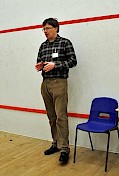The words of Goldsworthy (part 1)
 Last Saturday, 25 January, I attended the Crusade wargames show at Penarth. Crusade is a good start to the wargames year, having a good selection of traders, some excellent games and a good bring & buy, where I picked up a few tasty items. But you don’t really want a blog about how I had a great time going around with my mates (Casey and Chris!). Suffice to say it was a good show and if you missed it, it’ll be worth attending next year, judging by my experience of previous shows.
Last Saturday, 25 January, I attended the Crusade wargames show at Penarth. Crusade is a good start to the wargames year, having a good selection of traders, some excellent games and a good bring & buy, where I picked up a few tasty items. But you don’t really want a blog about how I had a great time going around with my mates (Casey and Chris!). Suffice to say it was a good show and if you missed it, it’ll be worth attending next year, judging by my experience of previous shows.
Of particular interest was the lecture given by Adrian Goldsworthy. I’ve attended Crusade for a number of years and always found these lectures very interesting. Sadly, Adrian’s co-speaker Rob Jones couldn’t attend as he was moving house.
Adrian opened by discussing the disparity between the way that wargames rules portray battles and what we know about actual battles from the sources. He used his two areas of expertise – ancient Rome and the Napoleonic era – as his examples.
Firstly, he spoke of the ancient period. Battles would tend to either be over very quickly and decided in the first clash, with one side breaking the other almost immediately, or be very prolonged. In fact, intimidation and morale had much more to do with whether troops would stand or simply flee with the first charge of the enemy. Some ancient armies would create a large amount of noise to impress and awe their foes. Others – such as Rome and Sparta – would approach in complete disciplined silence, apart from the sound of flutes. This lack of noise created its own form of intimidation. They would then unleash a torrent of shouts when combat was joined. Battles were far more mobile than our rather “static lines” of gaming miniatures would suggest, with units being pushed back (sometimes over a mile), while yet maintaining their fighting integrity.
 It was also common in history for units in combat to be reinforced by secondary units joining the melee. Adrian discussed the folly of the idea of units “supporting from behind” or of units “swapping positions”, which some rulesets allow. In reality, the men would have joined the unit in combat, adding to the weight of numbers. There was in his opinion no orderly withdrawal of one unit with a second unit charging in: I have be so lied to by HBO’s Rome! I can’t think of a rule set which allows a unit to join and combine with a friendly unit in combat.
It was also common in history for units in combat to be reinforced by secondary units joining the melee. Adrian discussed the folly of the idea of units “supporting from behind” or of units “swapping positions”, which some rulesets allow. In reality, the men would have joined the unit in combat, adding to the weight of numbers. There was in his opinion no orderly withdrawal of one unit with a second unit charging in: I have be so lied to by HBO’s Rome! I can’t think of a rule set which allows a unit to join and combine with a friendly unit in combat.
For the Napoleonic period, he addressed the myth of the bayonet charge. While vicious close combats happened in sieges and town fighting, they simply did not happen on the field of battle, with rare exceptions. If you charged an enemy they would typically retreat – and usually reform – or engage in combat, which in turn would cause your troops to halt short of the enemy and return fire.
The second and concluding part of this blog post will be published on Wednesday.
